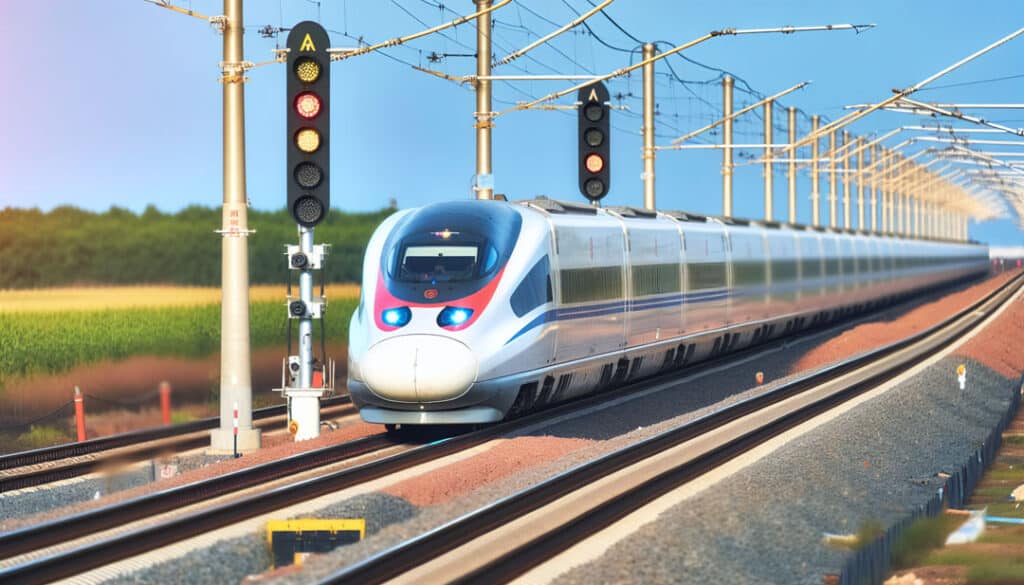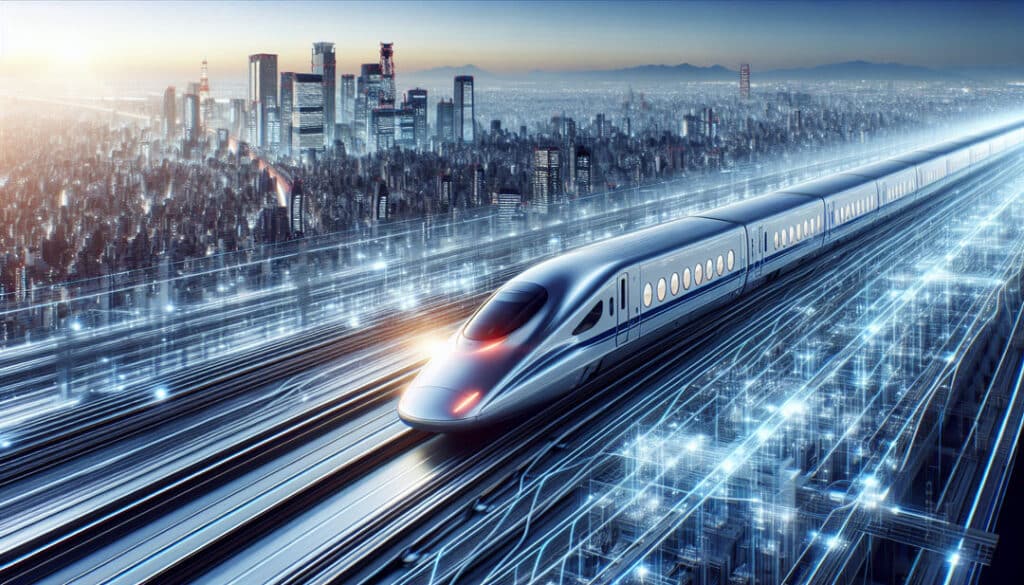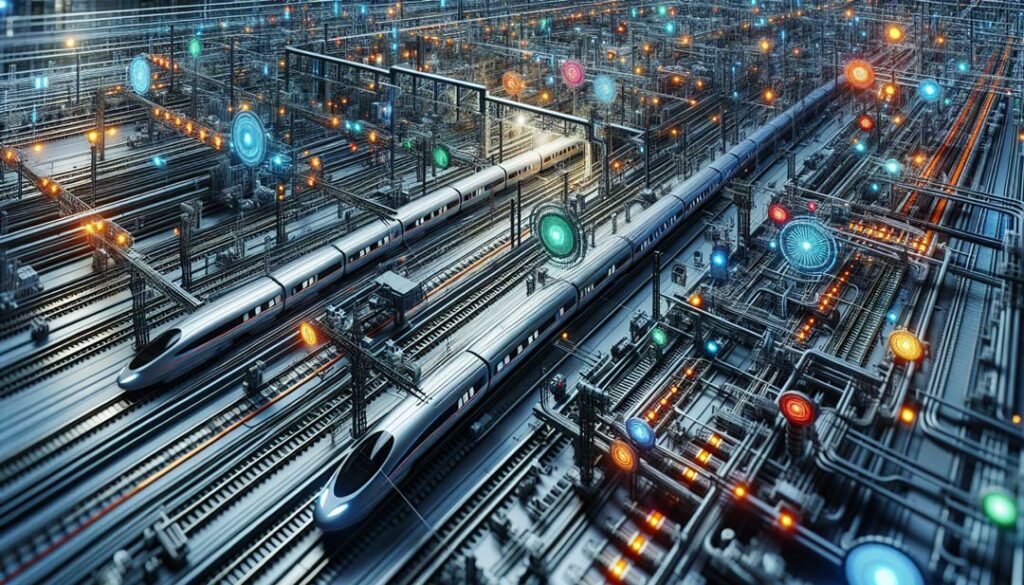How have high-speed trains transformed rail signalling technologies and infrastructure? The onset of trains traveling at velocities exceeding 250 km/h has triggered escalated demands on rail signalling systems, prioritising both safety and operability at these unprecedented speeds. Herein, we examine the pivotal upgrades, the intricate balance of signal timing with train speed, and the infrastructural and economic ripple effects such developments provoke within the rail industry—without diving too deep, too soon. In this context, we will discuss the impacts of high speed trains on rail signalling and its implications for the future of the industry.
Key Takeaways
- Advanced signalling systems are essential for the safe and efficient operation of high-speed trains, as they must accurately relay information and control measures at much higher speeds, incorporating technological innovations like digital and satellite-based systems.
- Synchronisation of signal timing is vital due to the unique challenges posed by high-speed travel, such as the Doppler shift; achieving millisecond accuracy is crucial for safety and efficiency, utilising modern technologies like 5G, RoF systems, real-time data, and predictive analysis.
- Upgrading railway infrastructure is necessary to support the advanced signalling systems of high-speed trains, with enhancements required in trackside equipment, power supply, and distribution systems, while integrating with existing lines to expand high-speed rail networks successfully.
Elevating Signalling Standards for High Speed Rail
High-speed rail, including maglev train systems, is classified as either new high speed line with speeds surpassing 250 km/h or existing lines with speeds exceeding 200 km/h. This necessitates advanced signalling systems to ensure safety and operational efficiency on the high speed rail line. The sheer velocity at which these trains operate makes precise communication and control paramount.
The signalling systems that support high-speed rail need to progress in tandem with the rail’s evolution and speed boundaries.
The Need for Enhanced Signalling
Current railway signalling systems for high-speed rail lines face several challenges, including legacy systems that jeopardise capacity utilisation and punctuality, along with the demand for high performance in terms of value for money, reliability, capacity, safety, and sustainability. To optimise traffic flow, enhance reliability, minimise delays, and ensure the safe operation of high-speed trains, deploying enhanced signalling systems becomes crucial.
The railway signalling system is the unsung hero of high-speed lines, managing the movement of railway traffic and upholding safety standards through the implementation of systems such as cab signalling and Automatic Train Control (ATC).
Technological Innovations in Signalling
Technological advancement has been a driving force in the evolution of high-speed rail signalling. For instance, France’s TGV, managed by SNCF, has implemented digital signalling systems to enhance communication and control, both essential for optimising high-speed rail operations. These digital signalling systems haven’t just been beneficial domestically; they have been instrumental in the TGV’s expansion into various countries such as:
- Italy
- Spain
- Belgium
- Luxembourg
- Germany
- Switzerland
- United Kingdom
- Netherlands
- Morocco
- China
- South Korea
This technology ensures consistent and reliable communication across diverse national rail networks, including the west coast main line, enhancing high-speed rail travel.
The European Union’s goal to establish a trans-European high-speed rail network heavily relies on digital and satellite-based signalling systems for improved connectivity among member states.
Safety Protocols and Signal Processing
In any transportation system, including high-speed rail, safety remains a paramount concern. In this regard, the recent advancements in safety protocols for high-speed rail signalling encompass a variety of measures, including:
- Communication-Based Train Control (CBTC)
- Positive Train Control (PTC)
- Automated Track Inspection
- Advanced Signalling Systems
- System-level fail-safe
- Parallel monitoring
- Tracking health monitoring technology
These measures contribute to achieving top speed safely by implementing safeguards such as emergency braking systems, trackside signals that detect obstructions, and learning from past accidents to improve the system.
The process of signal processing in high-speed trains entails the analysis of real vibration measurements to assess the operational status of components like the bogie, which is crucial for maintaining maximum speed safely.
The Synchronisation Challenge: High Speed Trains and Signal Timing

The challenging yet vital aspect of ensuring safety and efficiency in high-speed rail operations lies in mastering the synchronisation between high-speed trains and signal timing. The rapid speeds at which these trains operate introduce unique challenges such as the Doppler shift and changes in signal levels caused by movement within coverage beams.
To overcome these challenges, specific synchronisation signals in 5G NR networks or BeiDou timing and satellite communication are employed. This synchronisation of signal timing is crucial in ensuring safe and reliable operation, especially in high-speed environments where quick decision-making is imperative.
Achieving Millisecond Accuracy
In high-speed rail signalling, every millisecond counts. Efficient high-speed internet services and linear-cell-based radio-over-fiber (LC-RoF) systems are utilised to achieve millisecond accuracy in signalling systems for high-speed rail. This level of precision improves safety and enhances operational efficiency by:
- Enabling more reliable driver vigilance detection based on physiological signals
- Utilising deep learning for improved safety measures
- Providing comprehensive and precise evaluation capabilities
However, achieving and maintaining millisecond accuracy come with its own challenges, like addressing poor visibility, operator fatigue, and potential lack of attention. Automated real-time systems play a crucial role in detecting and addressing these issues.
Real-Time Data and Predictive Analysis
In the operation of high-speed rail signalling systems, real-time data and predictive analysis have emerged as essential tools. Real-time data facilitates the monitoring of trains and track conditions, detection of obstacles on the track, and the provision of alerts to the driver or activation of emergency brakes. On the other hand, predictive analysis utilises data analytics to proactively detect and resolve potential issues before they arise, enhancing reliability, safety, and efficiency.
Real-time data optimisation in high-speed rail signalling can:
- Enhance the stop schedule
- Minimise energy consumption
- Enhance line efficiency
- Reduce travel time
- Offer a graphical representation of the new timetable.
Impact on Train Schedules and Headways
The impact of high-speed trains on signal timing goes beyond just the trains themselves, affecting train schedules and headways, the time intervals between successive trains. Signal timing has a significant impact on train schedules and headways in high-speed railways as it determines the minimum headways between trains, based on absolute braking distances.
Discrepancies in signal timing for high-speed train schedules may result in inaccuracies in timetables, leading to impractical schedules and requiring intervention by traffic control. Therefore, the coordination and planning for managing signal timing in high-speed trains involve the establishment of signal coordination among a series of signalised intersections and the implementation of a coordinated cruise control strategy for the movement of multiple high-speed trains.
Infrastructure Upgrades: Preparing Tracks for High Speed Signalling

The infrastructure supporting high-speed rail must keep pace with the technology advances and the rail’s continuous evolution. Preparing tracks for high-speed signalling requires a slew of infrastructure upgrades, including:
- Point machines
- Train detection systems such as track circuits or axle counters
- Automatic train protection (ATP)
- Euro Balises for signalling
- Level crossing protection equipment
Power supply and its distribution also play a crucial role in the efficiency of high-speed rail signalling systems. As modern high-speed signalling systems are more advanced than traditional ones, they also bring about changes to maintenance protocols for trackside equipment.
Trackside Equipment Enhancements
Enhancing trackside equipment is a vital step in preparing for high-speed rail signalling. The trackside equipment has transitioned from traditional fixed signals and track circuits to modern in-cab computer displays and control centre systems, like the European Rail Traffic Management System (ERTMS), allowing for enhanced precision in control and communication.
Enhancements for trackside equipment in high-speed rail signalling comprise the utilization of modern in-cab computer displays, control centre systems, and enhanced train protection systems that monitor speeds and can apply brakes if necessary. However, these enhancements come with their own set of challenges, including the need to ensure more precise train control, increase capacity, improve safety, and protect from natural and human-made threats.
Power Supply and Distribution Systems
An upgraded power supply and distribution system is a necessity for supporting the increased demands of high-speed rail signalling. The necessary components in a power distribution system to facilitate high-speed rail signalling are:
- Traction power
- Signalling power supply (SPS)
- Power sources
- Distribution network
- Electrical loads
High-speed rail signalling generally employs alternating current (AC) for power distribution, whereas traditional rail signalling in the UK has traditionally relied on a two-wire 650V AC distribution system. The essential power backup systems required for high-speed rail signalling include UPS (Uninterruptible Power Supply) systems, such as those offered by ABB and Delta’s HPH series UPS.
Integration with Existing Lines
While integrating advanced signalling systems with existing lines presents challenges, it is crucial for the seamless operation and expansion of high-speed rail networks. Some of the challenges that arise when integrating advanced signalling systems with existing high-speed rail lines include:
- Compatibility issues
- The need for retrofitting existing infrastructure
- Ensuring seamless communication
- Maintaining interoperability with existing systems
- Upholding safety and reliability
To ensure compatibility with existing high-speed rail infrastructure, railway designers collaborate with equipment suppliers during the design phase. They conduct simulations to detect and resolve any possible issues, such as equipment or code failures, incompatibility, or location-specific factors that could impact the signalling.
Methods for integrating new signalling technologies with existing rail lines include:
- Adopting an integrated, whole-network approach
- Aligning infrastructure renewal with train fitment plans and franchise opportunities
- Deploying digital signalling and train control systems
- Enhancing network capacity for increased train safety
- Integrating climate resilience into signalling system design.
Economic and Operational Impacts of Advanced Signalling

Advanced signalling systems implementation on high-speed rail lines brings a myriad of economic and operational impacts. Some of the benefits of advanced signalling include:
- Enhanced line capacity on high-speed railways by incorporating extra balises between main and distant signals to convey infill or transitioning the system to a semi-continuous train control system
- Improved reliability and minimised delays
- Reduced need for line-side equipment
These benefits make advanced signalling systems a valuable investment for high-speed rail lines.
Advanced signalling decreases the interval between trains, enabling a higher number of trains to operate safely on a specific section of track. Additionally, it facilitates increased speeds on curves, leading to further reductions in journey time. However, implementing these systems requires a comprehensive evaluation of the prospective costs and benefits.
Cost-Benefit Analysis
Evaluating the economic feasibility of implementing advanced signalling systems on high-speed rail lines requires a thorough cost-benefit analysis. The implementation of advanced signalling systems in high-speed rail involves significant costs, as evidenced by the substantial expenditures in Control Period 5 where Network Rail’s signalling expenditure was around £800-900 million per year. However, despite the initial investment, advanced signalling systems are approximately three times more cost-effective than traditional systems and offer substantial financial benefits such as increased network capacity, reduced maintenance costs, and improved safety and efficiency.
When conducting a comprehensive cost-benefit analysis, it is crucial to consider factors such as:
- The decrease in travel times
- Better service quality
- Improved accessibility
- The development of high-speed rail as a mode of transport
- Calculation of time savings and operating cost reduction
- Avoided accidents
- Improved reliability
- The impact on local business activity
Increased Line Capacity and Throughput
Advanced signalling systems can significantly increase line capacity and throughput, allowing for more trains to operate simultaneously and efficiently. The capacity of high-speed rail systems is influenced by a range of factors such as terminals, junctions, stations, train frequencies, and train routing. Advanced signalling systems impact the line capacity by enabling closer train spacing, which allows railway operators to safely increase the number of trains on the same track and permits trains to run in both directions on the same track.
Enhanced line capacity and throughput have a direct positive impact on the overall efficiency of high-speed rail operations. This is achieved by allowing more trains to operate simultaneously, thereby minimising congestion and improving energy efficiency.
Reducing Journey Times
By significantly reducing journey times, the implementation of advanced signalling systems can improve overall service quality and passenger satisfaction. Some benefits of advanced signalling technology, such as ERTMS, include:
- Facilitating higher speeds for trains in curves, leading to reduced journey times
- Decreasing waiting time for passengers
- Minimising on-board discomfort
- Lowering the probability of service failures associated with staff and queueing times
These improvements can have a positive impact on overall service quality and passenger satisfaction.
Decreased travel duration on high-speed rail routes has been proven to result in heightened passenger utilisation. As high-speed rail services become more efficient, market share increases and air travel demand may decrease, demonstrating a clear correlation between travel time reductions and heightened passenger utilisation.
Case Studies: Signalling Success Stories on High Speed Lines

Valuable insights into the successful implementation of advanced signalling systems on high-speed rail lines come from case studies around the world. From the high-speed Shinkansen in Japan to the expansive European High-Speed Rail Network and the rapid development of high-speed rail in China, these case studies demonstrate the effectiveness of advanced signalling systems in enhancing safety, efficiency, and international connectivity.
Japan’s Shinkansen Systems
Known globally as the “bullet train,” Japan’s Shinkansen systems serve as a stellar example of advanced signalling technologies’ effectiveness. The current E5 and H5 Series Shinkansen trains have a maximum operating speed of 320km/h, demonstrating the effectiveness of Japan’s signalling systems in managing high-speed train operations with an impressive average speed.
The safety measures of the Shinkansen’s ATC signalling system include:
- Well-trained drivers
- Earthquake security measures
- Precautions for heavy rain and typhoons
- Track inspection systems
- Centralised traffic control operation at the Central Traffic Control Centre (CTCC) in Tokyo.
European High Speed Rail Network
Successfully integrating advanced signalling systems, the European High Speed Rail Network—a conglomerate of high-speed rail lines spanning multiple countries—has improved international connectivity and cooperation. The network has implemented the European Train Control System (ETCS), which serves as the signalling and control element of the European Rail Traffic Management System (ERTMS).
This system has played a pivotal role in improving international connectivity within the European High-Speed Rail Network by establishing a standardised signalling and train control framework across Europe, enabling trains equipped with the system to seamlessly operate on diverse rail networks.
Innovations in China’s Rapid Development
Innovative signalling technologies have supported China’s rapid development of high-speed rail, solidifying the country’s position as a global leader in high-speed rail infrastructure. China’s high-speed rail network is in a significant expansion phase and is projected to exceed 38,000 km by 2025, with long-term plans for 45,000 km.
A specific innovation in China’s high-speed rail signalling is the development of the Chinese Train Control System (CTCS), including CTCS-3 with operating speeds over 350 km/h. China’s rapid high-speed rail development has impacted global railway signalling standards through its collaboration with the International Union of Railways (UIC).
Summary
High-speed rail has revolutionised the transportation industry, making the world a more connected place. However, the backbone of this revolution lies in the complex network of advanced signalling systems. From elevating signalling standards to overcoming synchronisation challenges, from upgrading infrastructure to analysing the economic and operational impacts, every aspect contributes to the smooth functioning of high-speed rail systems. Our journey through the case studies of Japan, Europe, and China has further underscored the significant role of advanced signalling systems in enhancing safety, efficiency, and international connectivity.
The journey doesn’t end here. As technology continues to evolve, so too will the world of high-speed rail signalling. The future promises even more advanced signalling systems, paving the way for faster, safer, and more efficient rail travel. As we speed into the future, let’s keep our eyes on the tracks ahead, for the journey is as exciting as the destination.
Frequently Asked Questions
What is the signaling system for high-speed rail?
The signaling system for high-speed rail uses an automatic cab-signaling system called CATC, which transmits important data such as maximum speed, target speed, and distance to go via an induction cable installed along the track.
What are the effects of high-speed rail?
High-speed rail has various effects, including job creation, economic output, increased tourism, housing development, and regional development. It also reduces the physical and temporal distance between cities, improving accessibility and boosting location benefits.
What are the downsides of high-speed rail?
The downside of high-speed rail is that it can make train travel more expensive and less flexible, ultimately pushing more people into cars. Be mindful of these potential drawbacks when considering the implementation of high-speed rail.
Does the UK have high-speed rail?
Yes, the UK has high-speed rail. There are five lines in the UK that allow for high-speed rail travel, with maximum speeds ranging from 125mph to 186mph.
What are the criteria for categorising a rail as high-speed?
A rail is classified as high-speed if its speeds exceed 200 km/h, whether it’s a new or existing line.

